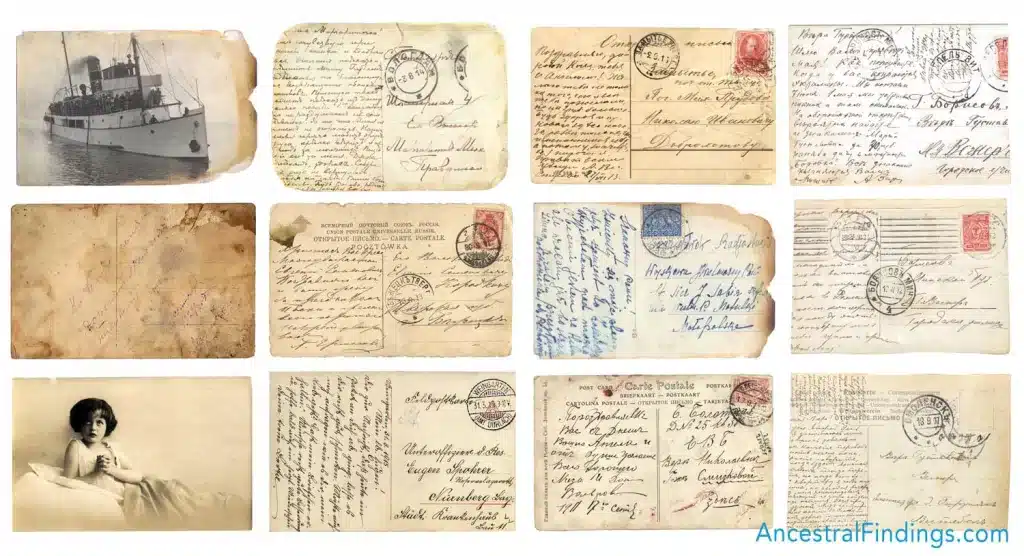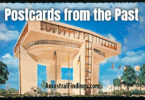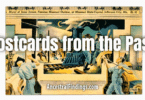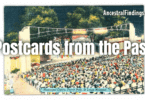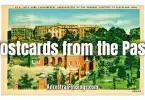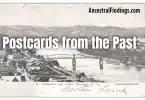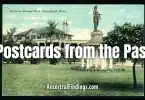Every postcard has a story to tell, and this one from my collection takes us into the world of Utah mining. The front of the card is filled with colorful illustrations of mines, towns, and the people who worked them. At the center is a portrait of an older prospector, George P. Watson, who spent nearly five decades searching for ore in Utah. Around him are views of famous mines: the Alta United Mine, Park City Consolidated Mine, Horn Silver Mine at Milford, the Utah Copper Mine at Bingham, and the Chief Consolidated Mine at Eureka. Together, these images form a kind of collage, showing how important mining was to Utah’s identity in the early 20th century.
On the back, the card has a short printed history. It calls Utah “a great storehouse of mineral wealth” and points out that more than two billion dollars’ worth of non-ferrous metals had been produced since the first prospecting began in 1854. It also notes that over 250 different minerals had been discovered in the state. The Bingham copper mine, it says, was the largest copper producer in the world at the time. It even mentions Utah’s deposits of coal and iron, which added to the state’s reputation as one of the most mineral-rich places in America.
The postcard was published by the Deseret Book Company of Salt Lake City, and it was made in Chicago by Curt Teich, one of the largest postcard printers in the United States. You can see the “C.T. Art-Colortone” mark along the edge, which was Teich’s signature style. The back also has a small box showing where to place a one-cent stamp. That tells us this card was printed in the era when postcards were still an inexpensive and popular way to share scenes from across the country.
I like this postcard because it doesn’t just show a single place; it tells a bigger story. The combination of images makes it feel like a snapshot of Utah’s mining history, as if the card itself was meant to remind visitors of the state’s most famous industry. It also puts a human face on mining with the prospector’s portrait. He represents the thousands of men who went into the mountains with only hope and hard work to guide them, and sometimes, if they were lucky, they struck a rich vein of ore.
Mining has been part of Utah since the earliest days of settlement. When prospectors arrived in the mid-1800s, they discovered silver, gold, lead, copper, and other valuable minerals. Entire towns sprang up around mines. Alta, featured on the postcard, was one of the first major mining camps, established in 1865. Park City, another place shown, became famous for its silver mines and grew into a thriving community. The Horn Silver Mine in Milford was one of the richest silver strikes in the West, and Eureka’s Chief Consolidated Mine was a big part of the Tintic Mining District, another hotspot of mineral wealth.
But the most impressive site of all was Bingham Canyon, also pictured here. Located near Salt Lake City, it grew into the largest open-pit copper mine in the world. What started as a small discovery in the 1850s became a massive industrial operation by the early 1900s. This postcard makes sure to point out that the Bingham mine was the “world’s largest producer,” which shows the pride Utahns felt in their mining achievements.
Mining shaped not just Utah’s economy, but its culture. The miners came from all over the world—Irish, Welsh, Chinese, Italians, Greeks, and many others—each bringing their traditions, foods, and languages. Mining towns were tough places, often with saloons, boarding houses, and a rough-and-ready spirit. Yet they also had schools, churches, and families trying to build stable lives. For many, mining was dangerous and uncertain work, but it was also the foundation for their communities.
The prospector at the center of this postcard symbolizes those early days, when men would head into the hills with picks, pans, and shovels, chasing rumors of silver or gold. By the time this postcard was published, mining had become more industrialized, with big companies running the major operations. Still, the romantic image of the lone prospector never faded, and postcard publishers knew it would appeal to buyers.
Looking at this card today, it’s more than just a colorful souvenir. It’s a piece of history. It captures a time when Utah was proud to be known around the world for its mines, and when postcards were a way to spread that pride far and wide. For me, as a collector, this card is a reminder of how everyday objects like postcards can preserve stories that might otherwise be forgotten. The people, the places, the industries—all are condensed into this little piece of paper.
Postcards like this one are why I enjoy collecting. Each has its own way of connecting us to the past. They don’t just show images; they give us glimpses into what mattered to people in their own time. And this one, with its focus on mining, tells us that in the early 1900s, Utah’s mineral wealth was something the state wanted to show off to the rest of the country.
If you happen to have any old postcards lying around your house, I’d love to see them. You can always send them my way. Just go to the contact link on AncestralFindings.com and let me know. I’ll be happy to share my address with you. Postcards like these deserve to be preserved, and they may even show up in a future article.
